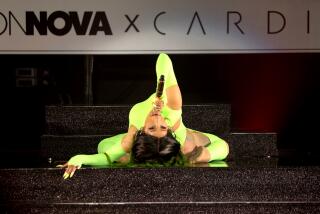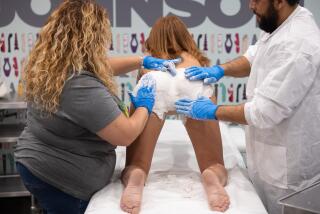New Image Made Over Into Success : Canoga Park: The restructured firm now peddles high-tech equipment to dentists. Its first venture, a beauty imaging system, was spun off separately.
Rarely has a corporate restructuring paid off so handsomely as it has for New Image Industries Inc.
Two years ago, New Image lost $12 million on about $8 million of revenue selling computer-imaging systems to beauty salons so customers could preview themselves in new hairdos. This year, the Canoga Park company expects to report that it earn ed $6 million for the 12 months that ended June 30 on revenue of $31 million--selling high-tech gadgets to dentists.
New Image now peddles intraoral cameras, digital X-ray machines and other dental equipment, mainly by direct-mail advertising, telemarketing and at trade shows.
Prices range from $9,000 for an intraoral camera--a miniature camera built into a dental hand-piece that lets patients see on a video monitor what a dentist sees in their mouths--to $30,000 for a system that combines the camera with a voice-activated periodontal charting system and digital X-ray machine. The only remnant left of the company’s old business is a computer-imaging system for dentists.
New Image’s transformation has been good for shareholders. When its old beauty business went sour, the stock hit a low of 56 cents a share. New Image closed at $9.88 on Monday in the national over-the-counter market.
Last year, New Image also did a make-over on its beauty business, re-incorporating it as Styles-on-Video Inc. Then in March, New Image spun off Styles-on-Video as a separate company by distributing all of its own Styles-on-Video stock--representing about 82% of Styles-on-Video--to New Image shareholders as a dividend. The rest of Styles-on-Video was held by its officers, directors and other investors.
Immediately after the distribution, Styles-on-Video issued all of its shareholders rights to participate in an initial public stock offering of one million new shares of Styles-on-Video on a one-for-one basis at $6 a share. That offering raised about $5 million.
Styles-on-Video still sells imaging systems to beauty salons. But about half its sales are now to entrepreneurs who buy the system for about $13,000 and operate it from kiosks and pushcarts in shopping malls. The company earned $921,000 on $1.5 million of sales in the nine months that ended March 31.
The new Styles-on-Video has also turned investors’ heads. Its stock, initially offered at $6 a share, nearly tripled in three months. That performance made Styles-on-Video the best-performing IPO of 1993’s first half, according to Securities Data Co., a New York investment research firm. It closed Monday on the American Stock Exchange at $16.75.
“All of this has been enormously gratifying,” said Robert Gurevitch, New Image’s 52-year-old chairman and chief executive.
When the company lost $11 million in 1991, he added, “It would have been a helluva lot easier to walk.”
Why didn’t he? “I don’t like to fail,” said Gurevitch, a born salesman who is on the phone wheeling and dealing by 5 a.m. every day. Previously, he built a successful Marina del Rey sportswear company. “I had a lot of confidence that if I could find a good product in an industry we knew something about, we could turn this business around,” he said.
New Image started out great. Gurevitch and three partners, one of whom designed computer-imaging software, founded the company in 1987 and took it public in 1989. Within a few months, investors had bid up the shares from $6.50 to more than $15.
Although beauty salons were the company’s mainstay, New Image also developed and sold computer-imaging systems for several other markets: architects, landscape designers, weight-loss centers, dentists and cosmetic surgeons.
Imaging systems all work the same way: Suppose a woman is thinking of changing her hairstyle. A hairdresser uses a video camera to take her picture. Then he calls up other styles in the computer’s database and superimposes them on the woman’s picture so she can see how they would look on her. With a video printer, she gets a videotape to take home.
New Image’s systems caught on quickly with high-priced hairdressers. By 1990, sales had zoomed to $12 million. The company went from 25 employees to 110 and opened several regional and international offices.
Then the bottom fell out. The beauty-salon systems cost $20,000 and only upscale shops could afford them. When the recession hit, even they weren’t buying.
Adding to its misery, New Image and four of its top officers were hit by a class-action lawsuit filed by a shareholder. The suit claimed the executives had issued misleading statements to boost the company’s stock price and that some of its officers sold their shares at a premium before disclosing the full extent of the company’s financial problems.
Under a proposed settlement reached in June, New Image would pay certain shareholders $2 million--covered by the company’s insurance--plus about 57,000 newly issued shares of its stock. The settlement must still be approved by the U. S. District Court in Los Angeles.
In early 1992, Gurevitch went shopping for a new product to sell and found it: the intraoral camera.
The device--not much larger than a toothbrush and with several interchangeable lenses--has brought in $12 million, or 80% of the company’s total revenue for the past two years. Gurevitch bought the patent from a small company in San Carlos for $1 million, half the cash New Image had left at the time, and some New Image stock.
At least 15 other companies make intraoral cameras and they and other such devices from companies including Fuji and Dentsply had been on the market since at least 1987. Priced at between $15,000 and $25,000, they were sold primarily by sales representatives who called on dentists.
Gurevitch decided early on to keep sales reps to a minimum, drop the price of New Image’s “AcuCam” to less than $10,000 and sell it by mail.
Today New Image “probably has 60% of the market,” said Jeanne Matson, publisher of Dental Products News, a trade paper based in Skokie, Ill. “Nobody else even comes close.”
To market its product, New Image sends a slick package advertising the camera and its other products every month to 100,000 dentists, orthodontists, periodontists and the like--nearly every dental professional in the United States--plus 10,000 more in Canada.
At New Image’s offices, two telemarketers take dentists’ calls on the company’s 800 number. Almost half those calls result in sales adding up to $700,000 a month, Gurevitch said.
Earlier this year New Image bought a manufacturing facility in San Juan Capistrano, where about 20 employees assemble its products from components made by Sony and Panasonic, among others. Another 50 people work at its offices in Canoga Park.
“The AcuCam saved the company, no doubt about it, but these guys are superb marketers,” said Steven Reid, an analyst at the Beverly Hills-based investment firm H. J. Meyers & Co.
Dr. Joel Miller, a Woodland Hills dentist who bought one of the New Image cameras last year, said it has increased his practice by between 20% and 30%.
“When patients can see the problem you’re talking about, they’re more likely to say ‘go ahead and fix it,’ ” Miller said. Two weeks ago, he also leased a digital X-ray machine from New Image. “Patients like to see you have state-of-the-art equipment.”
Dr. Dan Smith, an Agoura Hills dentist who specializes in cosmetic and restorative work, has a New Image intraoral camera and computer-imaging system. “It really helps me communicate with my patients,” he said. “It’s amazing how often what I think the patient wants is different from what they really want.”
As for Styles-on-Video, it has sold about 300 of its imaging systems to entrepreneurs such as small businesses in shopping malls. Customers pay $15 to $20 to see themselves in a dozen new hairstyles they can choose from a catalogue of 600 styles and get a videotape of the results to take home. Hair-care and cosmetics companies are also beginning to use Styles-on Video’s imaging system to promote their own products with demonstrations in department stores and warehouse clubs.
“We like to say, ‘Today a novelty, tomorrow a necessity,’ ” said Guy De Vreese, 38, Styles-on-Video’s chairman and chief executive.
Born in Belgium, De Vreese had his own Antwerp-based diamond import-export business before buying the license to sell New Image products in Europe in 1986. New Image later bought his distribution company and De Vreese became a New Image board member. He has run Styles-on-Video since it was reincorporated as a separate company, 82% owned by New Image last year.
The two companies’ split-up was amicable. Their executives sit on each others’ boards and remain friends.
“We wouldn’t be so successful today if not for the learning curve we had under New Image,” De Vreese said.
Happy Break Up
Both New Image and Styles-on-Video shareholders have benefited from the decision to split the two companies. Styles-on-Video has been independent since April. Monthly high and low closing bid prices per share: New Image closed at $9.88 on July 27; Styles-on-Video closed at $16.75.
More to Read
Inside the business of entertainment
The Wide Shot brings you news, analysis and insights on everything from streaming wars to production — and what it all means for the future.
You may occasionally receive promotional content from the Los Angeles Times.










